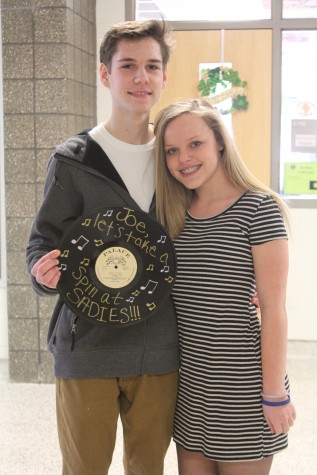Behind the Headdress
French teacher Melissa Saeed witnesses intolerance first hand after her conversion to Islam five years ago
PHOTO Monica Bradburn
Melissa Saeed was not hired into an easy job. Replacing former French teacher Sarah Armstrong would be challenge enough considering most IB French students had Armstrong since middle school. Saeed, however, faced the challenge of also being the first faculty member to wear a hijab, a headdress predominately worn by women in Islam.
“I was nervous when first coming to Fenton,” Saeed said. “I didn’t know how people would react. I didn’t want parents to not want their kids in my class because I’m Muslim. But everyone here has been absolutely wonderful.”
Saeed originally looked into the Muslim religion to better understand her Muslim husband and what he practiced.
“I have been Muslim for only five years,” Saeed said. “I married a Muslim and before that I was Baptist. I wanted to understand what my husband believed so through that I started researching and discovered that it was what I had always believed. I guess I have always been a Muslim and just didn’t know it.”
The only real visible difference between Saeed and her fellow faculty is the hijab she wears as a part of her religion.
“There are multiple reasons why we cover,” Saeed said. “It protects the family and the culture if people are practicing properly. This way men are not tempted to stray and cheat on their wives, not to say women don’t cheat, but it helps you keep your mind on what is important instead of just looks. When I get home I can take it off, but when I am in front of any other man that I could technically marry, I have to cover up.”
The transition from Baptist to Muslim was very natural for Saeed and wearing a hijab has been a something to take pride in. However, not everyone in her family has understood or supported her decision to convert to Islam.
“I am confident in it, but my parents are not at all comfortable with it,” Saeed said. “I hate to say it, but people are quite bigoted. For example, I have a relative who has lived in the same three miles their entire life so they do not understand anyone who is not Catholic. They love me, but don’t understand me and behind my back I have heard them call me one of those people. I guess that’s their choice.”
With her conversion to Islam, Saeed has witnessed intolerance toward her religion first hand.
“I am from a small farming town not far from here,” Saeed said. “I think there would be a strong hatred toward me because people don’t understand and aren’t even trying to. The first day I wore the hijab I surprised my friends from Howell, which is the home of the KKK. My friend’s mom was concerned that I was not safe there. I did not know not to feel safe because I’ve always been taught to be very tolerant. It is interesting to be on the other side of that now and realize how intolerant and ignorant people can be.”
This intolerance, according to Saeed, stems from misconceptions about Muslims that are used by the media and popular culture to sell a story.
“The media tries to promote fear and violence through sensationalism,” Saeed said. “Look what the news tells you about Muslims; most of these people are good people. It is the few extremists who get attention and distort everything.”
Despite the adversity Saeed has faced since her conversion to Islam, wearing a hijab has been something she takes pride in. For her, wearing the hijab has been relatively easy because she believes so strongly in it.





